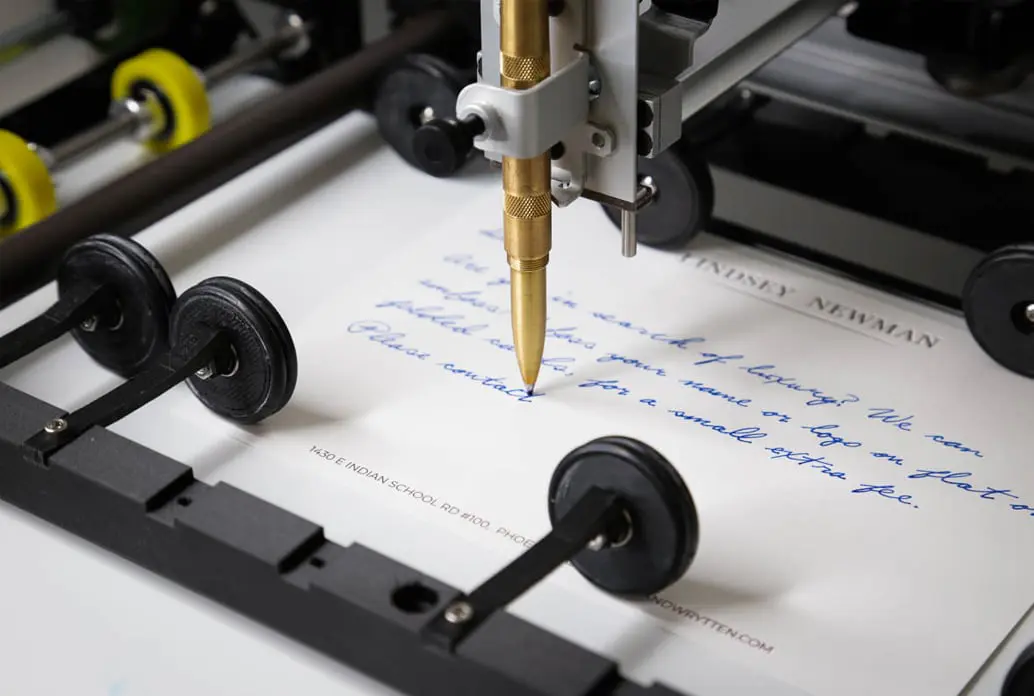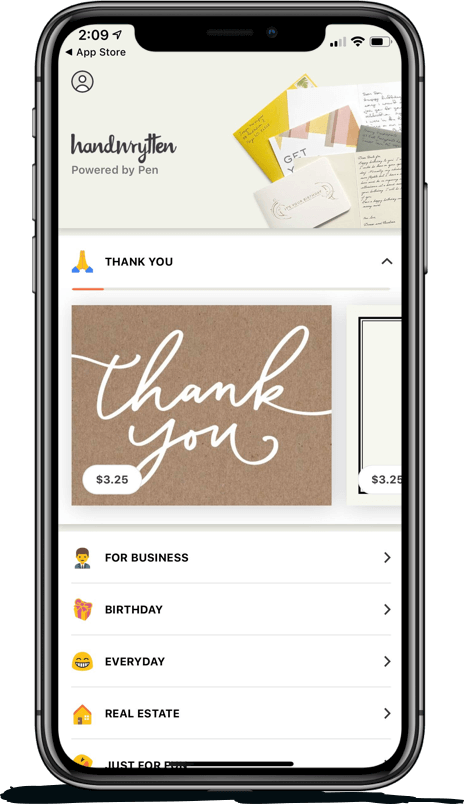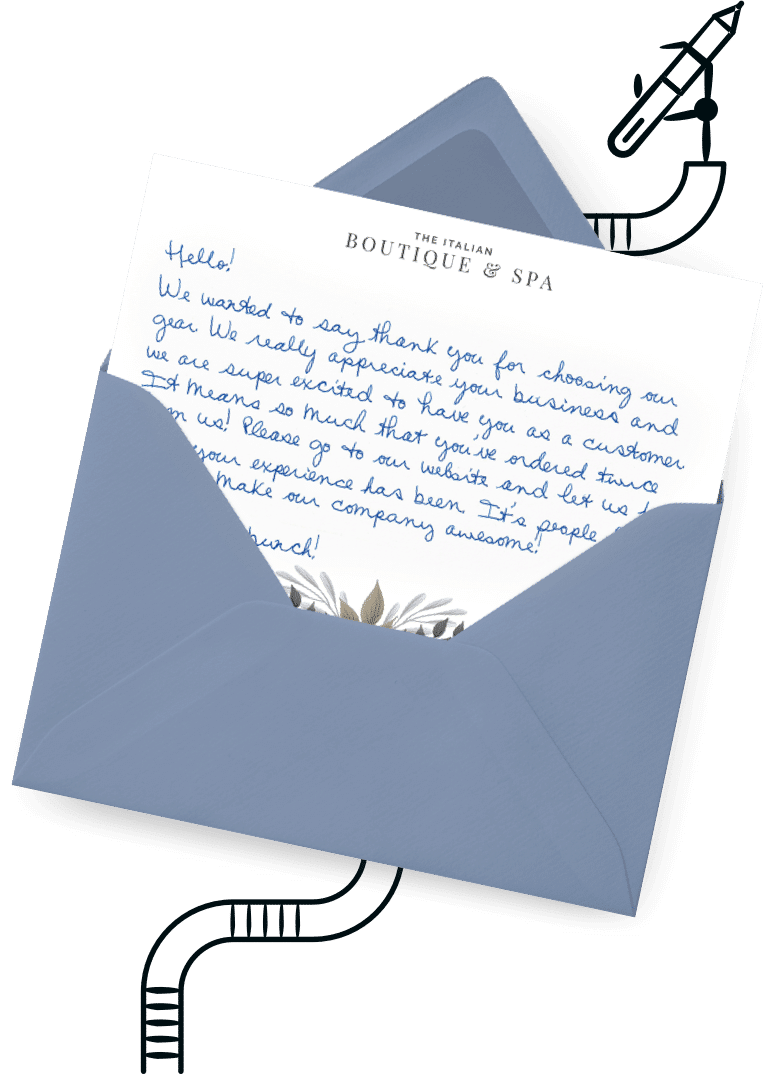
9280 S. Kyrene Rd.
Suite 134
Tempe, AZ 85284
Phone: +1 (888) 284-5197
Email: contact@handwrytten.com



You have been subscribed. Thank you!
Today, many of us rarely take time to put pen to paper. We text our friends to make social plans and email important business information to our colleagues. However, even modern etiquette experts agree you won’t find a better way to say “thank you” than writing a card or note. Writing a thank you letter or note conveys your gratitude in a meaningful and sincere way. Professional business notes can also improve your company’s image, boost sales, and increase referrals. Don’t be daunted by the thought of penning your thank you cards and notes and starting from a blank thank you card. The following failsafe tips will help you write the perfect thank you.
Benjamin Franklin once said, “If you fail to plan, you’re planning to fail.” Many people apply this quote to major undertakings such as saving money for a home purchase or completing large projects at work, but planning makes sense for smaller tasks such as writing generic thank you messages too. Perfection rarely happens on the first attempt. Creating a draft thank-you note gives you a chance to refine your message until you’re completely happy with it.
Write down your thank-you message on a separate piece of paper and read through it carefully. Does it say everything you want to say? Does it convey your message in the right way? Can you find ways to improve it? Make your changes, then set it down for an hour or two. When you come back to it later, you’ll see it with fresh eyes. Read through it again and make any more adjustments you’d like. You can copy your draft to your thank-you card or stationery. Having a draft to refer to can help you reduce your chances of making mistakes.
A thank-you message should never become an essay. Keeping your thank you note message short ensures that you get to the point without going off on unnecessary tangents. Brevity also helps you resist the urge to get too effusive with your thanks, which may make your message seem insincere.
If you struggle to keep your message short, try writing your thank-you notes on cards rather than pieces of paper. When you have only a limited space to work with, you’ll soon figure out what you need to say and what’s best left out.
We mentioned putting pen to paper in the introduction for a specific reason. Writing thank yous is best done by connecting your intention directly to paper via a pen. Typewritten thank-you notes and cards simply don’t have the same impact as handwritten ones. A handwritten thank you conveys warmth and sincerity. Your recipients know you wrote the message just for them and no one else. As handwritten correspondence becomes less frequent, receiving a handwritten note is becoming more precious and special.
If you need further convincing, consider that 64 percent of Americans prefer handwritten correspondence to electronic messages. In addition, handwritten envelopes get opened 300 percent more often than printed envelopes.
Writing handwritten notes can admittedly be a time-consuming task, especially if you’re sending many notes. If you’re short on time, consider using a handwritten letter service such as Handwrytten. Handwrytten creates personalized notes and cards for individuals and businesses that are virtually indistinguishable from messages written by hand.
When you’re giving thanks, you should always be specific with your expressions of thanks. Writing down what a person or company did for you, and the impact this act had on you, makes your thank-you messages more personal and impactful. It is key to make sure that the context is correct here – for example, you wouldn’t want to write a non-love related message in a wedding thank you card.
You should write your thank-you notes to acknowledge receiving gifts when you can’t verbally thank someone in person. This situation often occurs when someone sends you a Christmas present through the mail or you receive several gifts you open later, after a wedding or large milestone birthday, for example. Your thank-you card for these occasions will mention the exact gift you received and why you appreciate it.
You should also write a thank-you note when you receive an important card through the mail. People often send cards to convey their sympathy after the loss of a loved one, their congratulations on an engagement or birth of a child, to wish someone luck at a new job, and several other reasons. Returning the favor with a thank-you card demonstrates that you are grateful for the person thinking of you and wishing you well.
Sending thank-you cards and notes is also a valuable way to express gratitude in the professional world. You should send your thanks when people help you professionally. A written thank you after someone takes time to interview you for a position, mentor you, discuss a business proposition, or invest in your company can help strengthen your professional relationships.
Businesses should also send thank-you notes when they have meaningful interactions with other companies and individuals. Writing a thank you when customers refer other people to your business or buy your products or services is a great gesture of goodwill. When customers feel valued, they’ll be more likely to make purchases and refer others in the future. Thanking your employees for a job well-done boosts productivity and morale. Don’t forget about sending business thank you cards when your suppliers or contractors go the extra mile.
A very important part of any job interview is sending a quick follow-up to the hiring manager or person with which you interviewed. This is especially important for sales positions. Be sure to express your interest in the position and acknowledge you understand the hiring process might take some. If you send the note right after the interview, the speed of “snail mail” delivers the note a few days later, which is a great way to remind the company of your interest.
Sometimes the most impactful thank-you messages come seemingly out of the blue. You can’t find a bad time to send a thank you to a friend who has been there to support you for many years. Similarly, businesses can recognize the loyalty of their long-term customers, employees, suppliers, contractors, and investors with an unexpected thank-you note.
As discussed above, writing a thank-you message forges a more personal connection with your recipient compared to sending an email or text. However, take the wrong tone and you’ll undermine that connection.
Keep your tone personable and approachable. If you write in a formal way, you’ll create distance between yourself and your recipient. Forget the formalities, even if you’re writing on behalf of a business or writing to a professional contact. Instead, consider how you’d express yourself if your recipient was present and having a conversation with you. Use everyday words and phrases rather than ones you think might sound impressive.
Remember to be sincere. Even if you keep your tongue in cheek during your conversations, humor can be lost in the text. Unless you know your recipient well, skip the jokes and write straight from the heart. Don’t overdo it, as gushing can seem disingenuous, but write with honest gratitude.
Sometimes gestures fall flat. You know you should thank people for what they’ve done for you, but maybe something wasn’t quite right. Perhaps you received a gift in the wrong size, or the item was wrong altogether. Maybe an employee worked overtime, but you didn’t get the result you were after. A thank-you message isn’t the right medium for expressing what went wrong. Instead, focus on what you appreciated about the gesture.
For what it’s worth, the right time to mention what you didn’t like about the gesture may not ever exist. Maintaining good relationships is often better. Criticize people for the effort they put in, and they’ll be less likely to put themselves out for you in the future.
A thank-you message has one goal: Express your gratitude. Resist the urge to turn your note into a sales pitch. This action can be difficult when you’re writing thank-you notes for professional purposes. So much correspondence in this space is about selling, but don’t give in to temptation.
After a job interview, your thank-you note should simply thank your interviewer for taking the time to meet you. You shouldn’t spend time trying to convince someone that you’re the best candidate. You already had your opportunity during your interview. Similarly, you shouldn’t try selling your products when you’re thanking customers for their loyalty or referrals. If they decide to buy from you because the thank-you note made them feel positively toward your organization, that’s great. But it’s not the goal at this time.
When your thank-you note has a heavy sales pitch, it undermines your original intent and makes your message seem insincere. Save the sales pitches for interviews and marketing materials; they don’t belong in thank-you notes or cards.
Make sure the way you sign off your thank-you message leaves a good lasting impression. Your sign-off should be warm and personable. “Warmest thanks” and “With gratitude” are safe choices. If you’re especially close to your recipient, you may use “With love”, “Lots of love”, or “Love and thanks”. If you’re writing within a religious context, “God bless you” or “Blessings” may seem appropriate.
Remember to avoid formal sign-offs. While “Regards” and “Yours sincerely” are appropriate ways to close a business letter, they’ll seem cold and impersonal on a thank-you note. Luckily, we’ve got a perfect article for you: check out 10 Ways to Sign Off a Thank-You Card.
Errors of any type detract from your thank-you note, making it seem like you’ve written it in a rush or without care. Read through your thank-you note carefully before you send it and look for any spelling mistakes or grammatical problems. If you detect any mistakes, start again. While correction fluid can hide your mistakes, it can’t hide that you made them in the first place. Starting fresh is the best way to make a good impression with your thank-you note.
If you’re prone to making mistakes, take your time. Going slowly and thinking carefully about each word you write should help reduce your errors. Write your thank-you notes in a quiet place, free from distractions. Once your attention is diverted from your thank-you note, making mistakes becomes much easier. Remember that copying a draft rather than trying to compose your thank-you note on the fly is another great tactic for reducing errors.
When you’re giving thanks for a specific gesture or act, timeliness is everything. The more time passes, the less sincere your thank-you note will seem. Your recipient may even forget what you’re thanking them for in the first place.
Etiquette experts recommend writing and sending a thank-you note within a day or two of receiving a gift. This time frame is a good guideline for any type of thank you. Your thank-you card or note could be in transit for a few days, or longer if it’s traveling overseas, so sending your thank-you message early is essential for minimizing delays.
People understand that sometimes circumstances prevent you from sending thank-you messages as early as you’d like. For example, a honeymoon can delay a bride and groom sending all their thank-you notes for their wedding gifts. Everyone expects new parents to take some time adjusting to life with a baby. However, if your thank-you message is delayed, you should still endeavor to send it as early as possible, ideally within six weeks of the event or the moment for which you’re giving thanks.
If the time has gotten away from you, remember that sending a late thank-you note is better than failing to say thanks at all. Write your thank-you note and make sure to add a brief apology for the delay in expressing your gratitude. Send your note as soon as you can and resolve to prioritize writing and posting your next thank-you message sooner to ensure you don’t make delaying your thanks a habit.
You can find more occasions to be thankful for throughout your life.
As with anything you do, you’ll get better at writing thank-you notes with more practice. Don’t wait for the big, momentous occasions. You can find more occasions to be thankful for throughout your life. Get into the habit of writing thank-you cards regularly and you’ll notice you’ll feel more confident about composing them.
Creating handwritten thank-you notes and cards is still the best way to express genuine gratitude for gifts your receive or thoughtful acts of kindness. When someone does something nice for you personally or professionally, the tips presented above can help you write the perfect thank you.


Scale your handwritten outreach, creating positive impressions and long lasting bond.
Sign Up Today!


Over 100 designs to choose from or design your own. Our online card customizer makes it simple.
Check Out Our Cards!





